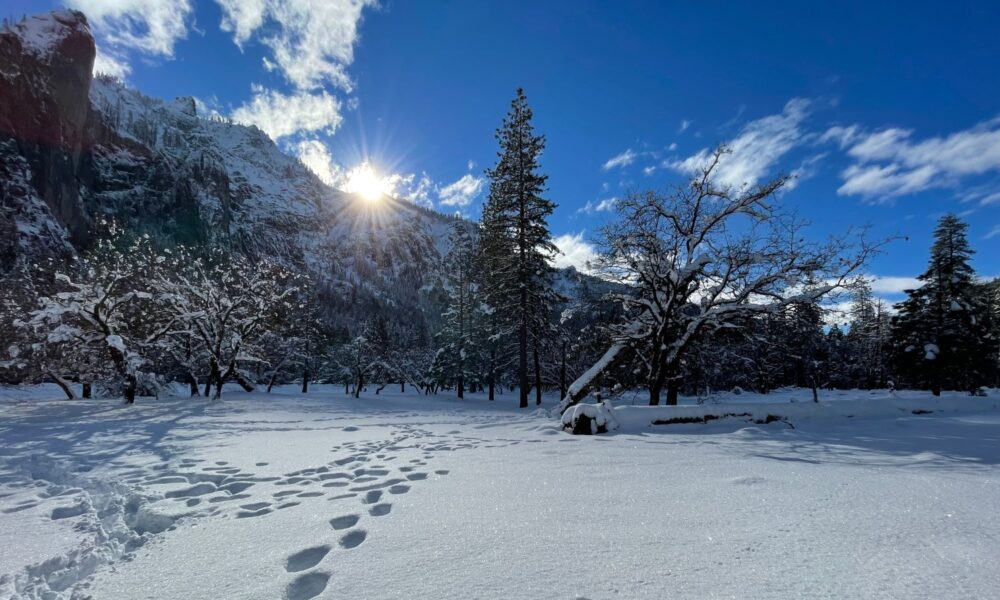Last week, I visited Yosemite National Park and walked along a gorgeous trail surrounded by snow-blanketed sequoia trees. Beyond the horizon of pine trees to the south lies the Sierra National Forest, and beyond the rocky horizon to the north lies the Stanislaus National Forest. Further beyond these national forests lies the rest of the expansive Sierra Nevada Mountain Range, spanning 400 miles.
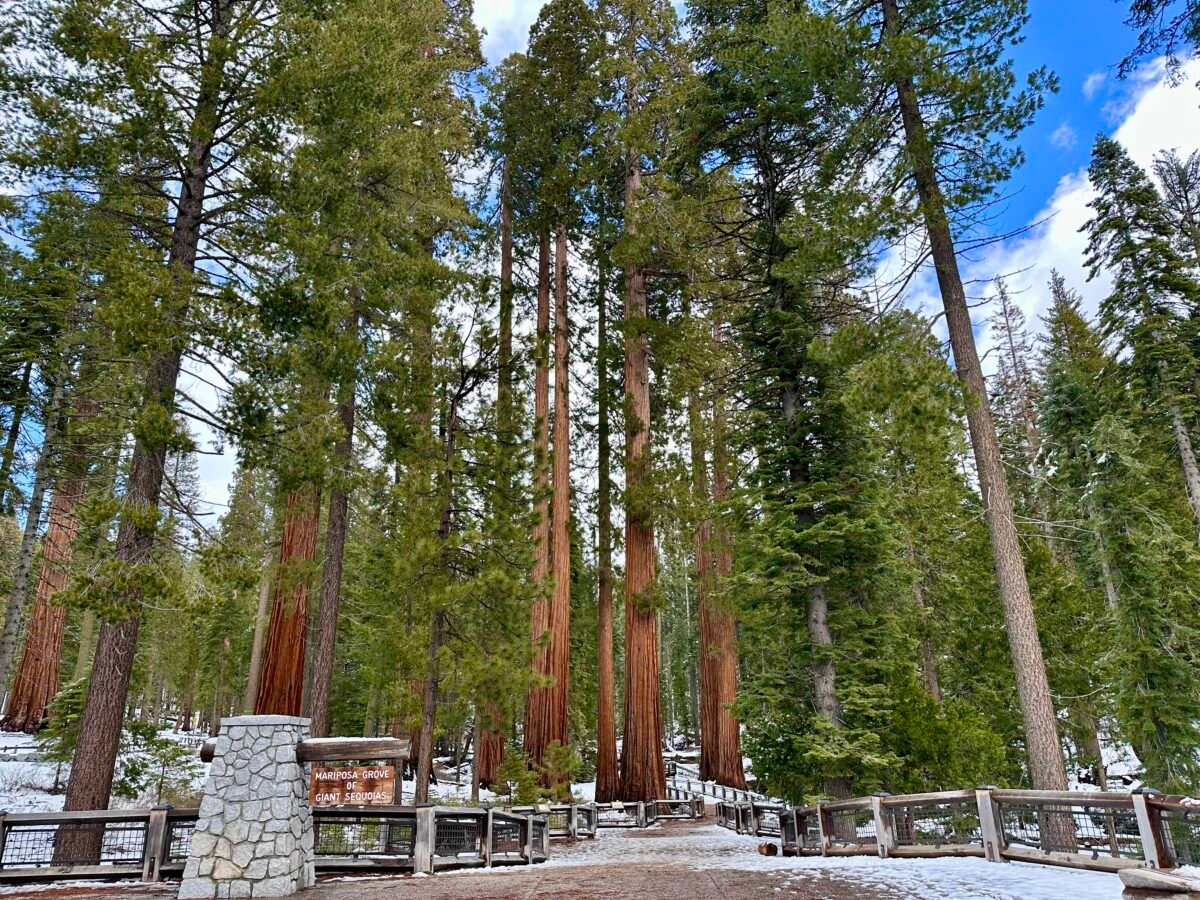
Tomorrow, April 2nd, the Department of Water Resources (DWR) will perform the last open-to-the-media snow survey of the year. These seasonal snow surveys offer a health check-up for our water system. If you’re a precipitation nerd, you can follow the livestream here.
The slow pace of snow at the start of this season worried water managers at first, but California has now exceeded 100% of the average for this time of the year.
Beyond this year’s measurements, it’s critical to consider what our snow levels mean for water management in a warming climate, and what needs to change so we can better prepare for the future.

As I appreciated the beauty of Yosemite’s snowy landscapes, I couldn’t help but wonder what they would look like in 10, 20, or 50 years, considering the continued effects of climate change—including wildfire and drought—on the landscape. The scenery I saw before me is undergoing serious transformations, with critical implications for the whole state.
California snow survey fun facts
What are some maybe not-so-fun facts, and how are these surveys performed?
- In California, snow surveys help the state forecast and manage the year’s water supply. Snow surveys not only measure the depth of the snow, but also its density to estimate how much liquid water there will be once it melts. This is known as Snow Water Equivalent (SWE).
- These snow surveys are part of the California Cooperative Snow Surveys (CCSS) program, which was established by the State legislature in 1929. Thanks to this program, there are more than 260 places throughout the state where either manual or electronic snow surveys take place.
- 2015 was the first year in which measurements going back to 1942 didn’t register any snow on April 1. That day, Governor Brown signed an Executive Order mandating a 25% water use reduction across the state.
- Last year, in April 2023, the manual survey recorded 10.5 feet of snow depth and a snow water equivalent of 4.5 feet—over 200% above the average!
- When low atmospheric pressure, strong winds, and high-temperature conditions materialize in the mountains, some snow transforms directly into water vapor (without melting first). This is a process known as sublimation. In the Sierra Nevadas, this process can result in a 10% reduction of snow water equivalent. (This happened last year, which helped alleviate the dreadful forecast of even bigger flood flows, especially into Tulare Lake. Still, the Tulare Lake, dry since the early 1900s, reached a surface area as large as Lake Tahoe.)

Beyond water supply, snow and rain also have other essential roles in California:
- In snow-abundant years, utilities produce more hydropower, which helps reduce fossil fuel consumption. However, in dry years, they rely more on the use of fossil fuels and nuclear energy.
- Farmers and farm managers often use snow survey information to select crop planting patterns, estimate groundwater pumping needs, and plan irrigation schedules.
- Similarly, reservoir operators apply these data to manage flood risks effectively, forecasting water inflows to maintain appropriate reservoir levels. This careful planning allows for sufficient water storage while balancing flood risk.
And if that wasn’t enough, here are four more reasons why everyone in California should care about snow.
1. It’s a natural form of water storage that provides about one-third of California’s water supply.
Our snowscapes are not just beautiful, but crucial for California’s water supply. The Sierra Nevada region (including part of the Southern Cascade Mountains) is essential for California’s ecosystems and communities as it acts as a natural water storage pool, holding snow throughout the winter. As temperatures rise during spring and summer, the snow melts and flows through rivers, feeding ecosystems and reaching California’s major reservoirs like Shasta, Trinity, Folsom, and Oroville in the North; New Melones, Don Pedro, and McClure fed by the Central Sierra; and Isabella dam, among others fed by the Southern Sierra.
The snow eventually melts and infiltrates into soils and aquifers across the state, resupplying soil moisture or natural groundwater storage systems. It also enters rivers, lakes, and reservoirs that serve different purposes, such as providing water for agriculture, supplying urban areas with drinking water (including large metropolitan areas like San Francisco and Los Angeles), producing hydropower, controlling salinity in the Sacramento-San Joaquin Delta, and even contributing to tourism and recreational opportunities. Overall, every year, the snowpack from the Sierra Nevada Region becomes part of the water that maintains ecosystems, supplies water to over 25 million people throughout the state, and sustains millions of acres of irrigated agriculture.
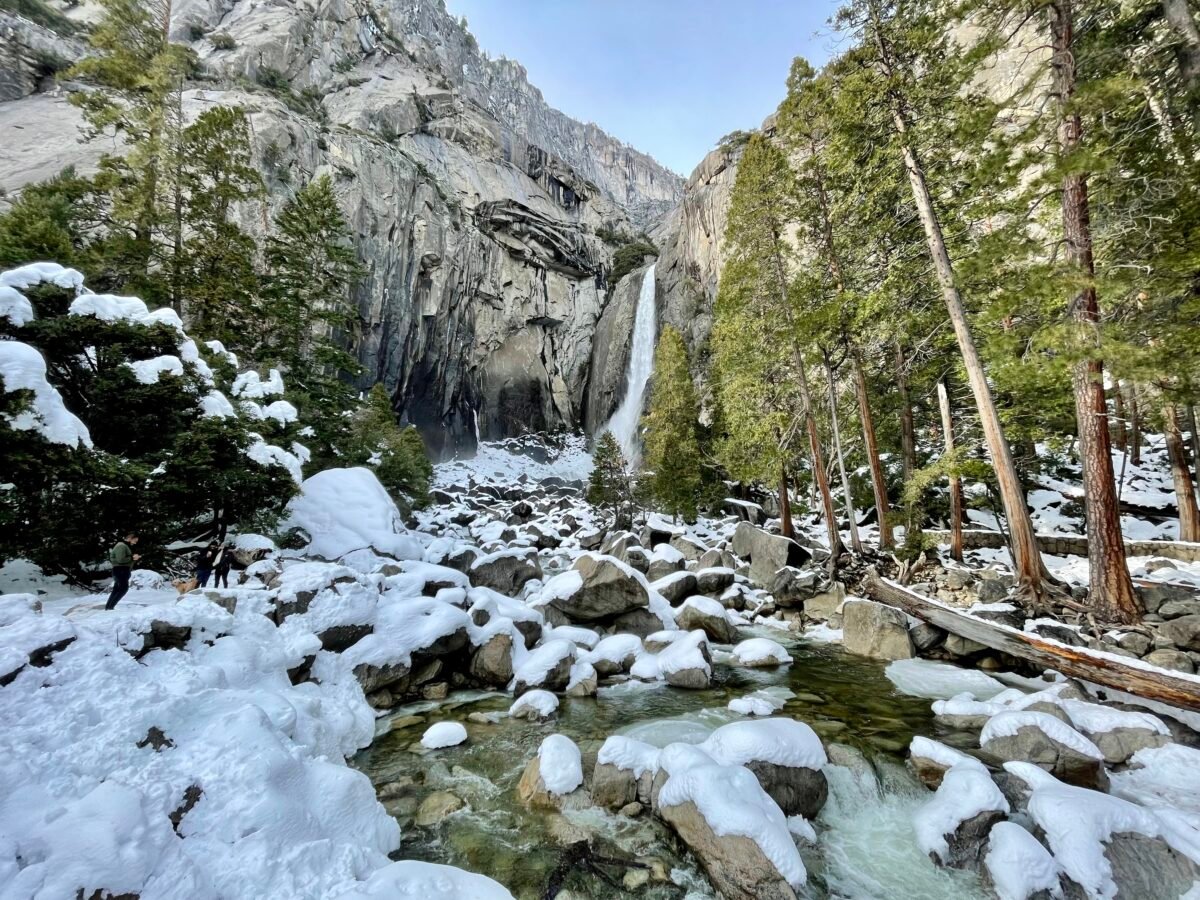
2. It’s vital for California’s agriculture and recreation economies.
Agriculture depends on a consistent and reliable water supply. Snowmelt is a major source of irrigation water: based on how much it snows each year, water managers forecast streamflow and surface water allocations for farmers so they can plan for the planting and watering of crops, which directly affects the agricultural economy. My colleague and friend Angel has written about California’s outstanding agriculture economic performance, with the San Joaquin Valley alone generating a revenue of $37.1 billion in 2020. A contrasting and unjust reality is that agriculture often uses clean snowmelt water to irrigate crops, while rural underserved communities live with dwindling and polluted groundwater. This points to the need for California’s conventional agriculture systems to be reformed and turned into sustainable agriculture. Such a process needs to consider economic, water, and social and environmental sustainability.
Also, while agriculture in California represents only between 1% and 2% of the state’s gross domestic product, food production in the state is very important for the whole United States. This responsibility justifies agriculture use of 80% of the water used in California. However, it can’t last. California needs to repurpose a significant surface of cropland, since we don’t have enough water to sustain our current practices. That could translate into a great opportunity for the rest of the United States to work on local food production—local agriculture can supply up to 90% of the food needs in the country.
Snow is also essential for tourism, rafting, recreational fishing, and skiing industries and contributes to local economies. If you have ever visited a Lake Tahoe ski resort, you know how many people head to the slopes to enjoy the snowy views. Tourists help maintain local businesses by spending money on hotels, meals, gear, “I forgot to pack” warm socks, and recreational activities. Consequently, snow is not just a seasonal feature of the landscape: it’s a key economic engine that supports businesses and mountain communities, making its preservation and management essential for the vitality of local communities.
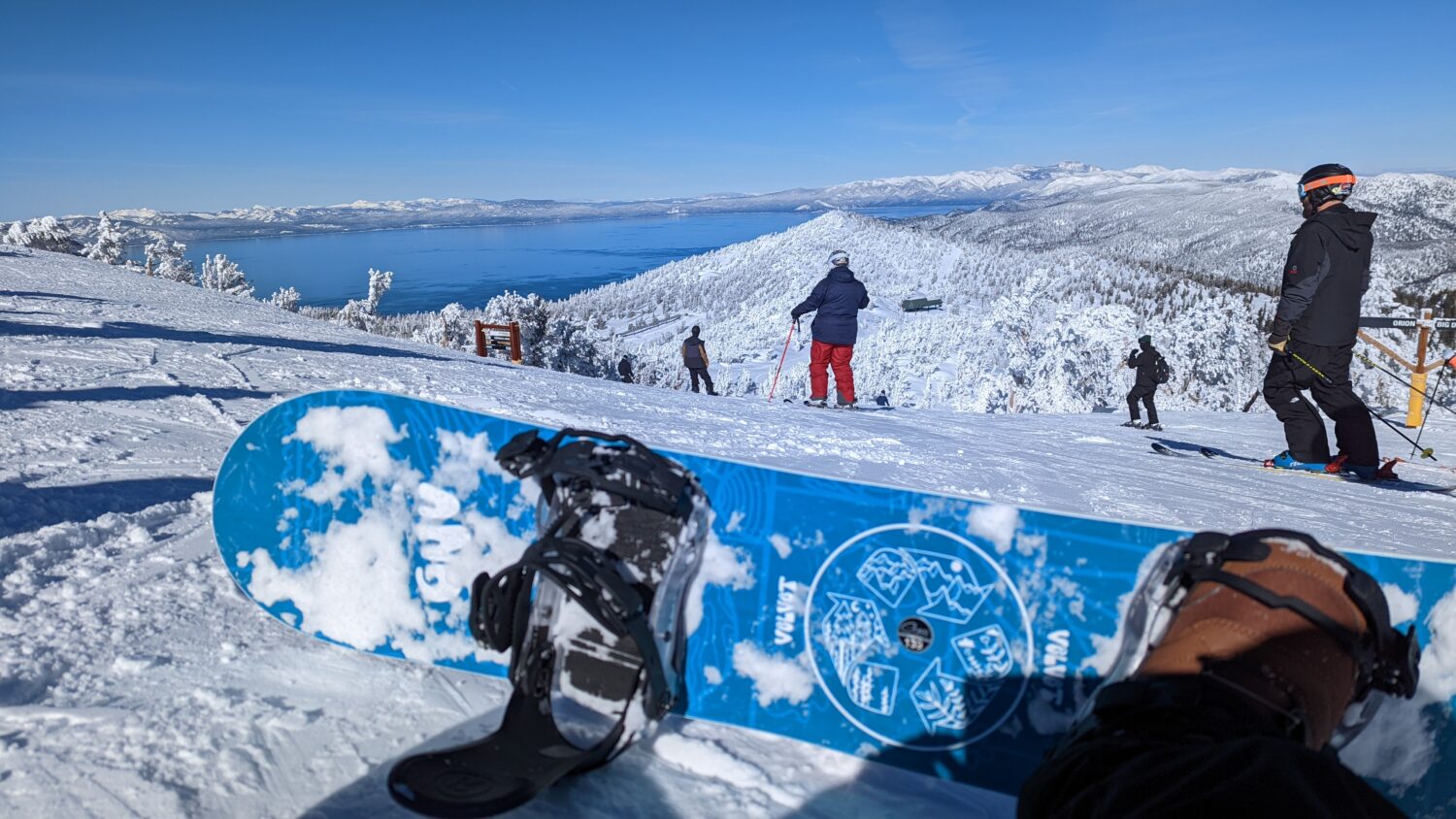
3. Too little snow is bad news for California’s water supply; too much is a risk to public safety.
The balance between too little and too much snow in California underscores the delicate dance of decisions that ensure both dry season supply and public safety. Understanding snowpack accumulation and its snow water equivalent helps estimate flood risks associated with rapid melting or so-called rain-on-snow events. This information is critical for flood management and emergency preparedness, protecting people’s lives and reducing the risk of damage to dams, levees, and other infrastructure.
This scenario is further complicated by 19th century colonial alterations to natural floodplains, which historically served as nature’s own flood management system. The conversion of these floodplains for agricultural use or urban development has stripped the San Joaquin Valley of its natural flood resilience, leading to increased vulnerability to flooding events.
Some local groundwater sustainability agencies are encouraging farmers to capture flood waters to perform groundwater recharge in their farms, which can help mitigate floods in vulnerable communities while giving farmers credits for groundwater storage. Of course, to protect water quality near rural communities, it is very important to understand how the land was previously used in order to address potential toxic substances in the soil (fertilizers, pesticides, and other chemicals) that could be dragged into aquifers during recharge. As we learn from past mistakes, there are efforts to reconvert certain cropland areas to natural flood plains to reduce California’s vulnerability to floods.
California recently designated groundwater aquifers as “natural infrastructure,” opening the door for funding to increase recharge while reducing flood risk. Also, research into forecast-informed reservoir operation (FIRO) is improving, and it can help resource managers be much more precise in reservoir management to store the right amount of water to guarantee flood protection and maximize water availability.
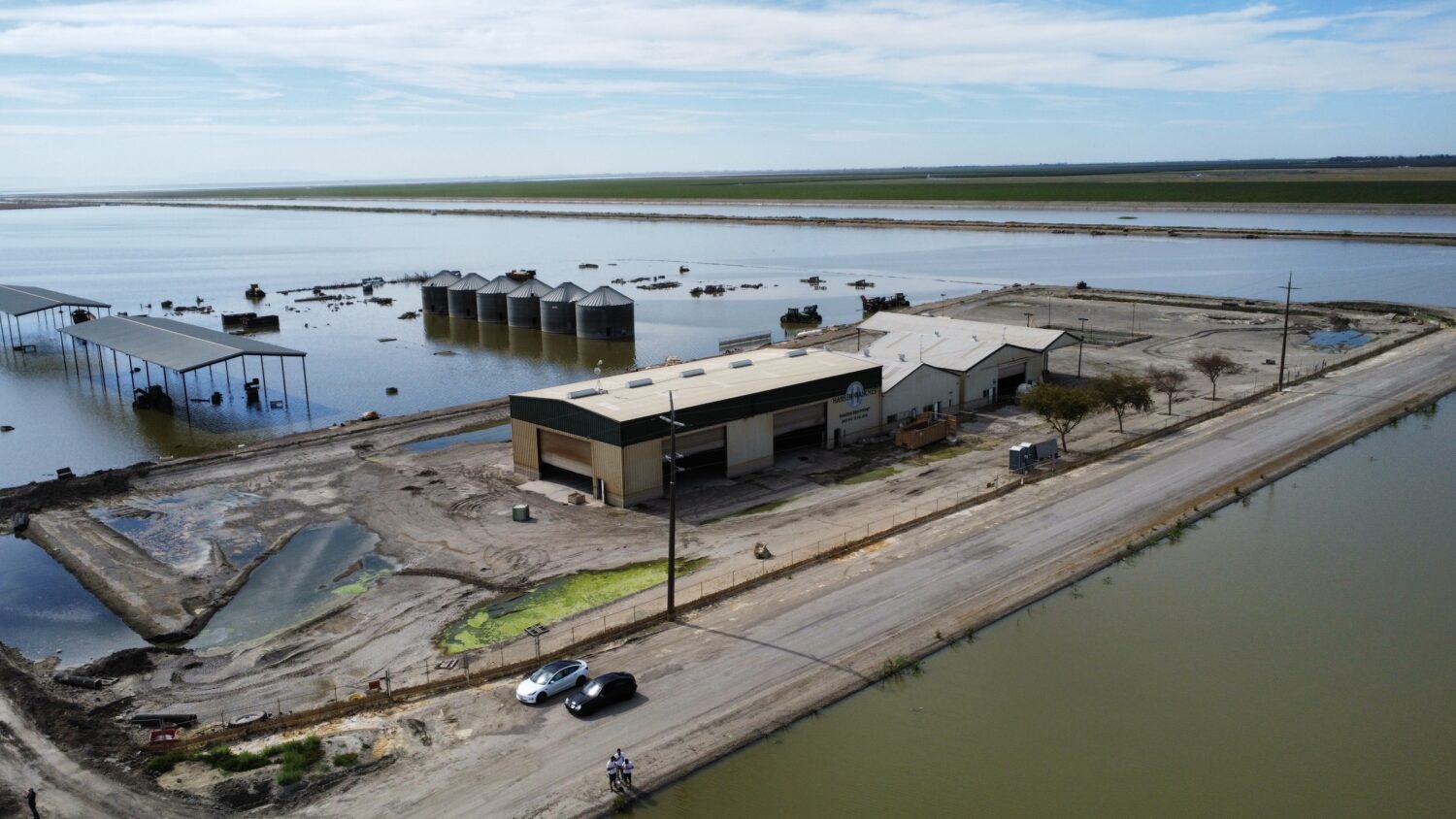
4. Snow is an indicator of climate change, with an uncertain future
Rising temperatures lead to more precipitation occurring as rain and less as snow. Higher temperatures reduce soil moisture and increase evapotranspiration, sublimation, and faster snowmelt. These dynamics result in diminished snowpack and changes in runoff patterns with implications for the various sectors reliant on California’s snowpack. As climate change poses increasing challenges to these sectors, the importance of adopting sustainable management and adaptation strategies is increasingly urgent. Such strategies ensure that snow continues to support economic activities while meeting environmental and community needs.
Wildfires add another layer of complexity. While low-intensity wildfires are increasingly being recognized as natural ecosystem processes thanks to traditional ecological knowledge, some recent high-intensity wildfires are far from natural. These fires not only devastate landscapes but also significantly alter the snowpack dynamics. The destruction of vegetation through intense burning can lead to increased snow accumulation, as fewer trees are present to intercept the snowfall. This seemingly beneficial increase, however, is offset by the darkened, ash and dirt-covered snow, which absorbs more sunlight and accelerates melting. Post-wildfire landscape increases runoff and erosion and, in many cases, worsens water quality. These factors change snowmelt patterns and complicate decision-making for water managers.
The compounding effect of wildfires on snow processes adds urgency to the need for comprehensive climate adaptation strategies. These strategies must account for both the direct impacts of reduced snowfall and the secondary effects of wildfires on the hydrological cycle, ensuring the resilience of California’s water resources in a changing climate.
Adding to the increased difficulty of future water management, Sierra reservoirs are increasingly misaligned with changing precipitation patterns, situated where snowfall is becoming scarce or melting prematurely in the season, which compromises their storage and supply capabilities.
Urban stormwater systems are another point of concern, particularly in areas where levees disconnected natural flood plains and where concrete and asphalt channel water into the streets, reducing the water that would naturally replenish soils and aquifers. This underscores the need for improved water capture and reuse strategies.
The San Joaquin Valley exemplifies the critical issue of groundwater over-extraction without adequate recharge, a practice that is unsustainable and jeopardizes both the quantity and quality of water resources. This systemic inadequacy calls for a comprehensive reevaluation and redesign of California’s water infrastructure, ensuring it is resilient, adaptable, and capable of meeting the demands of a warming state with reduced snow and its consequent hydrological shifts.
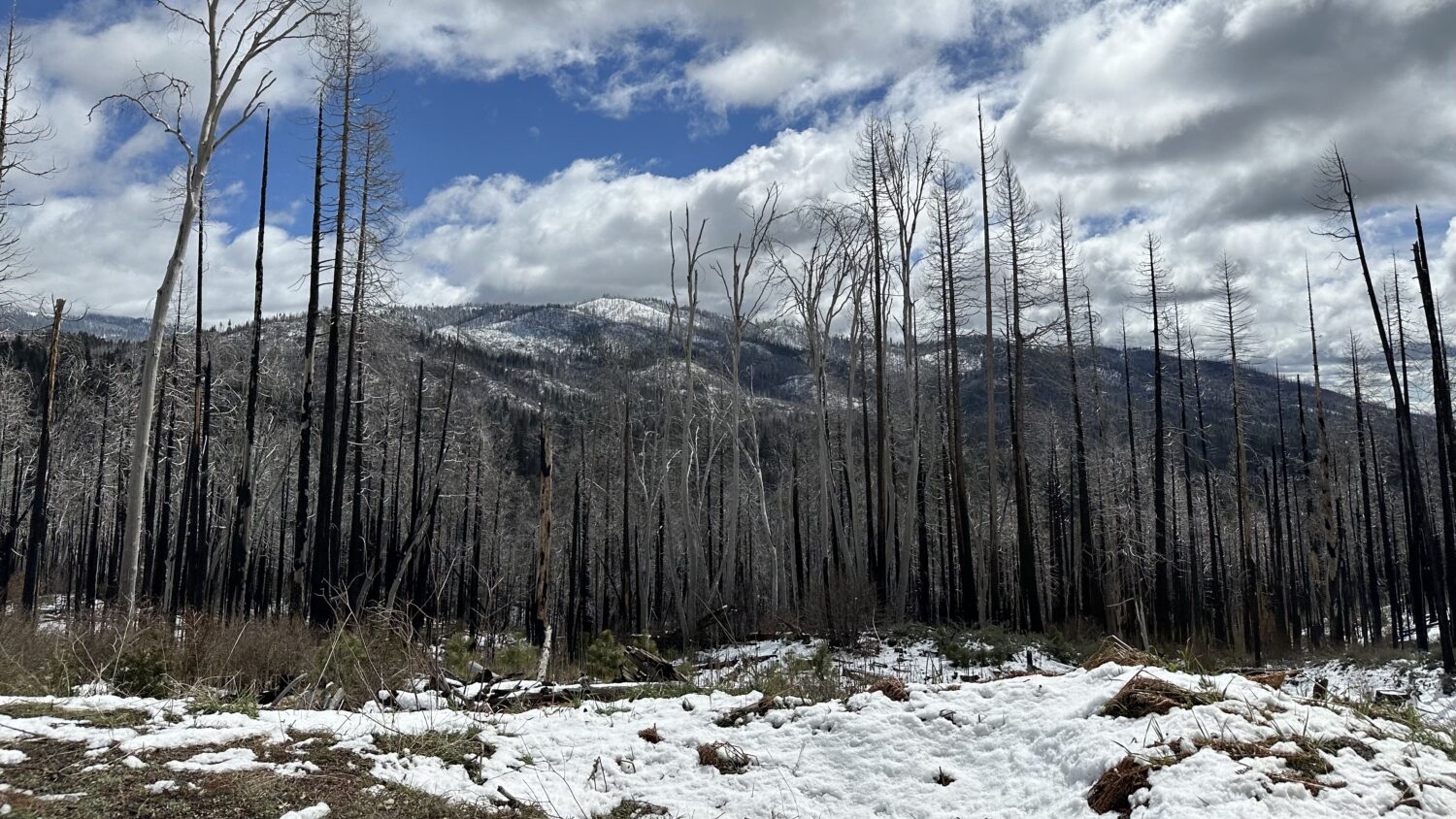
We need to act now to preserve the snow future
The snow in Yosemite and beyond the horizon in the rest of the Sierra impacts many of us in ways we may not realize. A future without snow is a future I don’t want to imagine.
A future with reduced snow, however, is imminent, and California state and local agencies need to plan for it. For the rest of us, in California and beyond, every action taken to reduce heat-trapping gas emissions, especially a fast and equitable phaseout of fossil fuels, will contribute to mitigating the impacts of climate change and reducing the vulnerability of communities and ecosystems to current and future harms.
